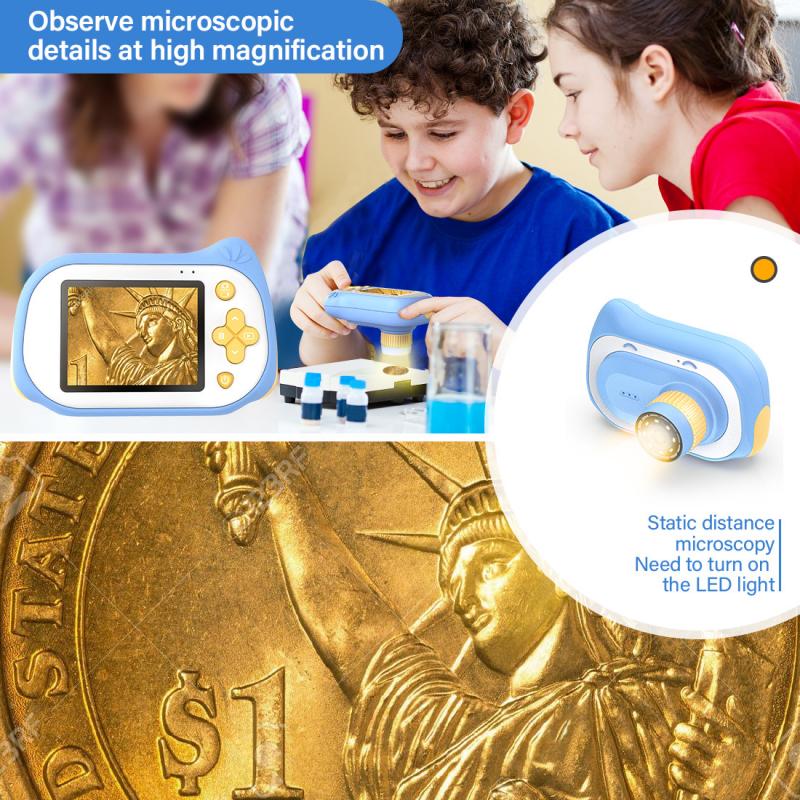What Can You See Under An Electron Microscope ?
Under an electron microscope, you can see extremely small objects and structures that are not visible to the naked eye or even under a light microscope. This includes details of cells, bacteria, viruses, and other microorganisms. The electron microscope uses a beam of electrons instead of light to magnify the sample, allowing for much higher resolution and greater detail. It can reveal the internal structures of cells, such as organelles like mitochondria or the nucleus, as well as the surface features of objects at a nanoscale level. Additionally, an electron microscope can be used to examine materials and their atomic arrangements, providing insights into the composition and structure of various substances.
1、 Cellular Structures and Organelles
Under an electron microscope, one can observe a wide range of cellular structures and organelles with exceptional detail and resolution. This powerful tool allows scientists to delve into the intricate world of cells and explore their complex architecture.
One of the most prominent structures visible under an electron microscope is the cell membrane, a thin barrier that encloses the cell and regulates the passage of molecules in and out. The electron microscope reveals the lipid bilayer of the membrane, as well as embedded proteins that play crucial roles in cell signaling and transport.
Inside the cell, various organelles can be observed. The nucleus, often referred to as the control center of the cell, appears as a distinct structure with a double membrane and a dense nucleolus. The electron microscope enables the visualization of chromatin, which consists of DNA and proteins, and is responsible for storing and transmitting genetic information.
Other organelles, such as mitochondria, endoplasmic reticulum, Golgi apparatus, and lysosomes, can also be observed under the electron microscope. These organelles play vital roles in energy production, protein synthesis, protein modification, and waste disposal within the cell.
Furthermore, the electron microscope allows scientists to study the cytoskeleton, a network of protein filaments that provides structural support and facilitates cell movement. Microtubules, microfilaments, and intermediate filaments can be visualized, providing insights into cell shape, division, and motility.
In recent years, advancements in electron microscopy techniques, such as cryo-electron microscopy, have revolutionized the field. This technique allows the imaging of biological samples in their native state, providing unprecedented details of cellular structures and organelles. It has led to groundbreaking discoveries, such as the visualization of protein structures at atomic resolution.
In conclusion, the electron microscope has been instrumental in unraveling the intricate world of cellular structures and organelles. It has provided scientists with a deeper understanding of cell biology and continues to push the boundaries of knowledge in this field.

2、 Microorganisms and Bacteria
Under an electron microscope, one can observe a wide range of microorganisms and bacteria in intricate detail. The electron microscope uses a beam of electrons instead of light, allowing for much higher magnification and resolution. This enables scientists to study the fine structures and characteristics of these tiny organisms.
Microorganisms, such as bacteria, viruses, fungi, and protozoa, can be visualized under an electron microscope. Bacteria, in particular, can be examined to understand their morphology, cell wall structure, flagella, pili, and other surface appendages. This level of detail is crucial for identifying and classifying different species of bacteria.
Furthermore, an electron microscope can reveal the internal structures of microorganisms. For example, it can provide insights into the internal organelles of protozoa or the complex reproductive structures of fungi. This information is vital for understanding their life cycles, reproductive strategies, and overall biology.
In recent years, electron microscopy has also been instrumental in studying the interactions between microorganisms and their environment. For instance, researchers have used electron microscopy to investigate the mechanisms by which bacteria adhere to surfaces, form biofilms, or interact with host cells during infection. These studies have provided valuable insights into the pathogenesis of infectious diseases and have contributed to the development of new therapeutic strategies.
Moreover, advancements in electron microscopy techniques, such as cryo-electron microscopy, have revolutionized the field. This technique allows scientists to visualize biological samples in their native, hydrated state, providing a more accurate representation of their structures and functions.
In summary, an electron microscope allows scientists to observe microorganisms and bacteria at a level of detail that was previously unattainable. It provides insights into their morphology, internal structures, and interactions with their environment. With ongoing advancements in electron microscopy, our understanding of these tiny organisms continues to expand, leading to new discoveries and applications in various fields, including medicine, microbiology, and environmental science.

3、 Nanomaterials and Nanoparticles
Under an electron microscope, one can observe a wide range of nanomaterials and nanoparticles with exceptional detail and resolution. Nanomaterials refer to materials that have at least one dimension in the nanoscale range, typically between 1 and 100 nanometers. These materials exhibit unique properties and behaviors due to their small size and high surface-to-volume ratio.
When viewed under an electron microscope, nanomaterials reveal intricate structures and surface features that are not visible to the naked eye or even with conventional microscopes. For example, carbon nanotubes can be observed with their tubular structure and graphene sheets can be examined for their atomic arrangement. Metal nanoparticles, such as gold or silver nanoparticles, can be visualized with their distinct shapes and sizes, which greatly influence their optical and catalytic properties.
Moreover, an electron microscope allows scientists to investigate the morphology, size distribution, and aggregation state of nanoparticles. This information is crucial for understanding their behavior and interactions in various applications, including medicine, electronics, and environmental science. For instance, in the field of nanomedicine, researchers can examine the size and shape of drug-loaded nanoparticles to optimize their delivery and therapeutic efficacy.
In recent years, advancements in electron microscopy techniques have enabled even more detailed analysis of nanomaterials. High-resolution transmission electron microscopy (HRTEM) and scanning transmission electron microscopy (STEM) techniques can provide atomic-scale resolution, allowing scientists to study the arrangement of atoms within a nanomaterial. This level of detail is essential for designing and engineering nanomaterials with specific properties and functionalities.
In conclusion, an electron microscope is a powerful tool for studying nanomaterials and nanoparticles. It allows scientists to visualize their structures, surface features, and size distribution, providing valuable insights into their properties and potential applications. With ongoing advancements in electron microscopy techniques, our understanding of nanomaterials continues to expand, opening up new possibilities for their utilization in various fields.

4、 Crystals and Crystal Structures
Under an electron microscope, one can observe the intricate details of crystals and their crystal structures. The electron microscope uses a beam of electrons instead of light, allowing for much higher magnification and resolution. This enables scientists to study the atomic and molecular arrangement within crystals.
When examining crystals under an electron microscope, one can see the individual atoms that make up the crystal lattice. The high resolution of the electron microscope allows for the visualization of atomic arrangements, revealing the precise positions of atoms within the crystal structure. This information is crucial for understanding the properties and behavior of crystals.
Moreover, electron microscopy can provide insights into defects and imperfections within crystals. These defects can significantly impact the physical and chemical properties of crystals, such as their strength, conductivity, and optical properties. By studying these defects at the atomic level, scientists can gain a deeper understanding of crystal growth, deformation, and the mechanisms behind various crystal phenomena.
In recent years, advancements in electron microscopy techniques have further expanded our understanding of crystals. For example, aberration-corrected electron microscopy has improved the resolution and clarity of images, allowing for the observation of even smaller features within crystals. Additionally, in-situ electron microscopy techniques enable the real-time observation of crystal growth and transformations, providing valuable insights into dynamic processes.
Overall, the electron microscope has revolutionized our ability to study crystals and crystal structures. It has allowed scientists to explore the atomic and molecular world within crystals, leading to advancements in materials science, solid-state physics, and various other fields.




























